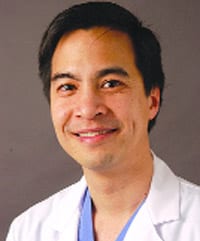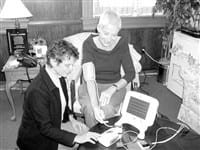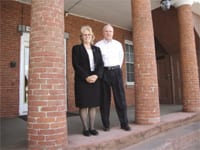Catching Up on Some Reading Pediatric Hospitalist Masters the Art of Understanding His Young Patients
Dr. Wayne Hioe calls it “the art and science of reading children.”
This is the essence, or a big part of it, of being an effective pediatrician, said Hioe (pronounced Hue), who has wanted to work with children for about as long as he can remember, and is thus quite content in his role as a pediatric hospitalist at Cooley Dickinson Hospital in North-ampton.
Elaborating on this notion of “reading” as it pertains to his patients, Hioe said that many of those he treats are very young — under 2 years of age — and thus they cannot effectively communicate how they’re feeling or where it hurts. At least, not with words.
“Adults can tell you what’s going on, but sometimes, what they’re telling you isn’t exactly helpful, and they’re not doing it on purpose,” he explained. “They’re trying to read their body, and often it’s difficult for them to do that. With kids, they tell you through their behavior in a way that’s often more clear than actually talking to adults.
“When a child that’s 10 months old comes in, it can’t talk, so you have to go by how it acts,” he continued. “When a child who is sick but not doing too badly comes in, he or she will fight you and scream their little head off; that’s their nature, they don’t want to be there — they’ll fight you off. When they come in and they don’t do that — when they don’t cry and they don’t get that upset — this is not a good sign.”
Reading signs is part of the job description for Hioe, who is one of five pediatric hospitalists at CDH and thus part of a growing, highly successful venture. Hospitalists are specialists who treat and look after those who are in the hospital. Pediatric hospitalists are a relatively recent phenomenon, individuals who care for children up to age 18 (but mostly very young) who are in the hospital for everything from a visit to the emergency room to a several-night stay.
The work is varied and highly rewarding, said Hioe, who told The Healthcare News that he works with two constituencies — his young patients and their parents — and both have critical needs.
In this issue, The Healthcare News looks at how Hioe and others who take this title go about meeting them.
It’s Not Child’s Play
Hioe, who grew up in Rochester, N.Y., took what would have to be a circuitous route to the current point in his career. Stops have come at the Community Health Center of Franklin County in Turners Falls, St. Peter’s Hospital in Albany, and the Cherokee Indian Hospital in Cherokee, N.C.
“It was a wonderful, wonderful experience,” he said of his time in North Carolina earlier this decade. “It was a small town of maybe 12,000 people with this small hospital. The doctors did a little bit of everything — we did inpatient, outpatient, and emergency-room work; you didn’t specialize in one kind of work as you would in a bigger-city hospital. We did everything, and it was really neat.”
Backing up a bit, Hioe said he didn’t really develop a strong interest in medicine until after he arrived at Tufts University for undergraduate work. But there was always an interest, or fascination, with children and working on their behalf.
“I’ve always loved working with kids, so much I thought I’d even do it for free,” he said. “When I was a teenager, I worked with kids every summer and realized that this is what I wanted to do with my life.”
It was in medical school (Albany Medical College, affiliated with Union University) that Hioe came to realize that pediatrics meant working with both healthy and sick children, a bridge he knew he could cross. “That’s what medical school and, specifically, work in pediatrics does — it reinforces not only that people love working with kids, but so much so that you love them even at their worst.
“Most of pediatrics is not just getting the child better,” he continued, “but also getting the family through a very traumatic time in their lives; seeing a sick child is pretty devastating.”
It was while in medical school that Hoie met Dr. Mary Chmura, whom he would eventually marry. The two studied together and did residencies (Hioe’s in both internal medicine and pediatrics) in Albany, but at different medical facilities.
After working for several years at the Cherokee Indian Hospital directly after residency, and then with two children, Hioe and Chmura knew they wanted to return to the Northeast — near their families (his in Rochester and hers in Springfield). After developing a fondness for rural, mountainous topography — the Indian hospital was near Smokey Mountain National Park — they focused their sights on Western Mass. And for Hioe, the next line on his résumé would be medical director of the Community Health Center of Franklin County.
There, he handled pediatrics and internal medicine attending, and while he enjoyed the work, he eventually sought a new challenge, one less defined by red tape and paperwork.
“I was thinking that it was a good time for a change and to do something different,” he explained. “I love primary care, but there’s some frustrations with it; there are a lot of burdens placed on primary-care physicians — 20{06cf2b9696b159f874511d23dbc893eb1ac83014175ed30550cfff22781411e5} of your time is spent doing paperwork, and with every step you take there’s always a barrier and you have to prove why you want to do something, and that’s tough.”
Hioe talked with a friend who was a pediatric hospitalist at CDH, and became intrigued by the job description and day-to-day duties as they were explained to him. He joined the hospital in September 2007, and has become a key player in an emerging department that has succeeded in greatly reducing the number of young patients who are transferred from CDH to other area facilities, especially Baystate Medical Center and its children’s hospital.
Describing his work, Hioe said he is one of a staff of seven — four full-time and three part-time — who care for children while they are in the hospital. This constituency includes newborns — healthy babies and those classified as mildly premature (at least 35 weeks) — and also children from a few months of age up to 18 years who are staying in the hospital’s pediatric wing for one of any number of reasons.
There are usually between six and 10 children in the hospital at a given time (more in the winter, which is peak time), he continued, and the average length of stay is about three days. During that time, the pediatric hospitalists, working four 12-hour days to provide 24/7 coverage, work with parents and, often, the child’s primary care physician to diagnose and treat ailments including dehydration, gastroenteritis, urinary tract infections, and myriad others.
The advent of the pediatric hospitalist has enabled CDH and other hospitals to treat more children, and children who are sicker, in the hospital setting.
“Our mission is to assist and partner with pediatricians and family-practice doctors who work outside in the community to continue their quality work in the hospital,” he explained. “Because we’re here all the time, we’re taking care of a lot of kids who would have been transferred to Baystate or another hospital in years past.
“We’re reduced our transfer rate to Baystate by 40{06cf2b9696b159f874511d23dbc893eb1ac83014175ed30550cfff22781411e5} since our program started,” he continued. “That’s a significant decrease, and we want to take that number even lower.”
Talking the Talk
When asked what he likes most about his work, Hioe said it’s the interaction he gets with both children and their parents, and developing relationships, for however long they may last.
“It’s all about reading the kids and developing that rapport,” he explained. “But it’s also working with the caregivers, the parents. It really is an art and a science, and it’s what makes this work so special.”
And with that, he was off to do some more reading.




Comments are closed.